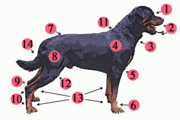
Stifle joint
Encyclopedia

Hind limb
A hind limb is a posterior limb on an animal. When referring to quadrupeds, the term hind leg is often instead used....
s of quadruped
Quadruped
Quadrupedalism is a form of land animal locomotion using four limbs or legs. An animal or machine that usually moves in a quadrupedal manner is known as a quadruped, meaning "four feet"...
mammal
Mammal
Mammals are members of a class of air-breathing vertebrate animals characterised by the possession of endothermy, hair, three middle ear bones, and mammary glands functional in mothers with young...
s such as the sheep, horse
Horse
The horse is one of two extant subspecies of Equus ferus, or the wild horse. It is a single-hooved mammal belonging to the taxonomic family Equidae. The horse has evolved over the past 45 to 55 million years from a small multi-toed creature into the large, single-toed animal of today...
or dog
Dog
The domestic dog is a domesticated form of the gray wolf, a member of the Canidae family of the order Carnivora. The term is used for both feral and pet varieties. The dog may have been the first animal to be domesticated, and has been the most widely kept working, hunting, and companion animal in...
. It is the equivalent joint to the human knee
Knee
The knee joint joins the thigh with the leg and consists of two articulations: one between the fibula and tibia, and one between the femur and patella. It is the largest joint in the human body and is very complicated. The knee is a mobile trocho-ginglymus , which permits flexion and extension as...
. It is often the largest synovial joint
Synovial joint
A Synovial joint, also known as a diarthrosis, is the most common and most movable type of joint in the body of a mammal. As with most other joints, synovial joints achieve movement at the point of contact of the articulating bones....
in the body.
The stifle joint consists of the femorotibial articulation (femoral and tibial condyle
Tibial condyle
Tibial condyle can refer to:* Medial condyle of tibia* Lateral condyle of tibia...
s), femoropatellar articulation (femoral trochlea
Trochlea
Trochlea is a term in anatomy. It refers to a grooved structure reminiscent of a pulley's wheel.Most commonly, trochleae bear the articular surface of saddle and other joints:* Trochlea of humerus* Trochlear process of the Calcaneus...
and the patella), and the proximal tibiofibular articulation.
The joint is stabilized by paired collateral ligaments which act to prevent abduction/adduction at the joint, as well as paired cruciate ligaments. The cranial cruciate ligament and the caudal cruciate ligament restrict cranial and caudal translation (respectively) of the tibia
Tibia
The tibia , shinbone, or shankbone is the larger and stronger of the two bones in the leg below the knee in vertebrates , and connects the knee with the ankle bones....
on the femur
Femur
The femur , or thigh bone, is the most proximal bone of the leg in tetrapod vertebrates capable of walking or jumping, such as most land mammals, birds, many reptiles such as lizards, and amphibians such as frogs. In vertebrates with four legs such as dogs and horses, the femur is found only in...
. The cranial cruciate also resists over-extension and inward rotation, and is the most commonly damaged stifle ligament in dogs.
'Cushioning' of the joint is provided by two C-shaped pieces of cartilage called menisci which sit between the medial and lateral chondyles of the distal femur and the tibial plateau. The main biomechanical function of the menisci is probably to divide the joint into two functional units—the 'femoromeniscal joint' for flexion/extension movements and the 'meniscotibial joint' for rotation—a function analogous to that of the disc dividing the temporomandibular (jaw) joint. The menisci also contain nerve endings which are used to assist in proprioreception.
The menisci are attached via a variety of ligaments: two meniscotibial ligaments for each meniscus, the meniscofemoral from the lateral meniscus to the femur, the meniscocollateral from the medial meniscus to the medial collateral ligament, and the transverse ligament (or intermeniscal) which runs between the two menisci.
There are between one and four sesamoid bones associated with the stifle joint in different species. These sesamoids assist with the smooth movement of tendon/muscle over the joint. The most well-known sesamoid bone is the patella, more commonly known as the 'knee cap'. It is located cranially to the joint and sits in the trochlear groove of the femur. It guides the patellar ligament of the quadriceps over the knee joint to its point of insertion on the tibia. Caudal to the joint, in the dog for example, are the two fabellae, which lie in the two tendons of origin of gastrocnemius. Fourth, there is often a small sesamoid bone in the tendon of origin of popliteus in many species. Humans possess only the patella.
In the horse and ox, the distal part of the tendon of insertion of quadriceps ('below' the patella) is divided into three parts. An elaborate twisting movement of the patella allows the stifle to 'lock' in extension when the medial portion of the tendon is 'hooked' over the bulbous medial trochlear ridge of the distal femur. This locking mechanism enables these animals to sleep while standing up.

